https://edition.cnn.com/2018/07/13/asia/japan-floods-intl/index.html
'Training thunderstorms' made Japan's floods even deadlier
'Training thunderstorms' made Japan's floods even deadlier
Tokyo (CNN)Koji Sunomori couldn't see the boy's face, but he knew the lifeless body belonged to his 2-year-old stepson, Kenta. He was wearing his favorite baseball shirt.
Sunomori found him among the rubble of what was supposed to be his new home. The 54-year-old had just married his wife Nana last month, and was planning to move in with her and her two children from a previous marriage in the coming days.
But Nana, her two children and her mother were caught last week in one of the deadliest storms to ever hit Japan. Massive rains caused flash flooding and landslides, one of which flattened Nana's home in Kumano.
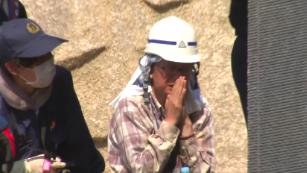
Koji Sunomori
Her body was found a few days after last week's torrential rain, but the children and Sunomori's mother-in-law were not. Sunomori scoured the detritus for any sign of his family. When he found Kenta Thursday, he dropped to his knees, squeezed his palms tightly, and prayed.
"I found him, finally," Sunomori told himself when recalling the story to local reporters, including CNN affiliate TV Asahi.
Kenta is one of the more than 200 people who have been killed in the aftermath of the downpour, as flash floods enveloped streets and landslides swallowed parts of the small towns that dot the Japanese countryside.
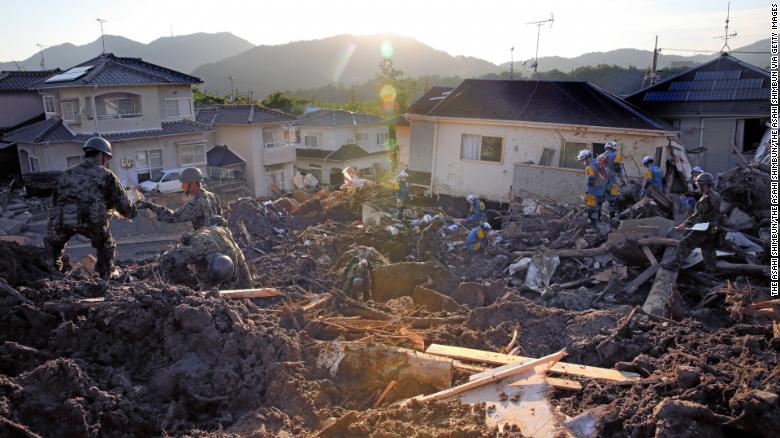
Japan Self-Defense Force members conduct search operations Wednesday in Kumano, Hiroshima.
Another 54 people remain unaccounted for, Japanese Chief Cabinet Secretary Yoshihide Suga said Friday. Some 73,000 personnel deployed by the government are still conducting search and rescue operations. After that, the clean-up efforts are expected to be massive.
"The region itself was experiencing rains, but some of these villages have never had rains of this magnitude before," said Naomi Akamatsu, an emergency relief coordinator from the Japan Red Cross.
"The impact of the disaster itself is increasing more than what we were expecting."
Why Japan's floods were so deadly
Experts say the floods inflicted so much damage -- and so many deaths -- because a unique set of weather conditions led to a massive amount of rain pummeling an area not prepared for it.
The rain hit a mountainous region, which meant the water picked up speed as it flowed down. The areas hit by those waters were, like much of rural Japan, home to an elderly population who cannot evacuate easily.
"When it's a sudden onset event, you don't have time for people to get out of the way," said Doug Bausch, a science adviser at the Pacific Disaster Center, an consultancy that works in disaster risk management.
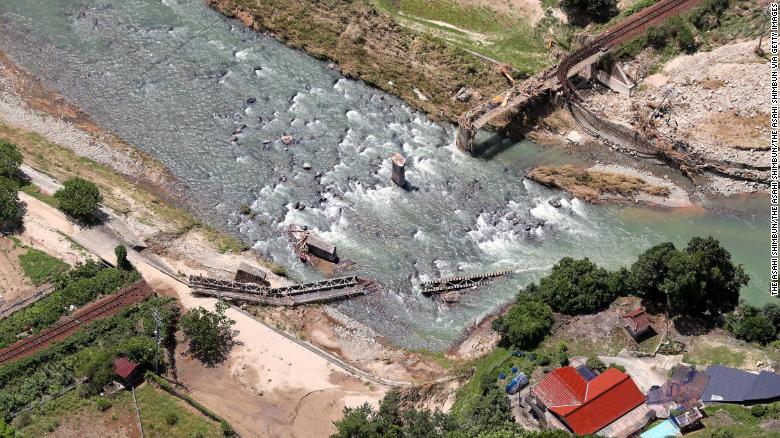
This aerial image shows the destroyed iron bridge of JR Geibi Line due to torrential rains in Hiroshima.
Akamatsu with the Japan Red Cross told CNN that her organization has heard many of the victims were elderly. Those who live in the Japanese countryside are typically older than city dwellers, in a country that's seen the average age of its population rise in recent years.
The massive amount of rain was caused in part by a phenomenon meteorologists call the "training" of thunderstorms. When atmospheric conditions are just right, a thunderstorm can create multiple storms behind it, essentially lining up and inundating the same region over and over.
It's called "training" because the storms line up like the cars of a train.
In this case, the warm, humid summer air was continuously wrung out like a sponge, high in the mountains to help create this effect -- and some areas felt it to the tune of more than a dozen inches of rain in a mere two hours, according to NHK.
"The amount of the rain was enormous. It was unprecedented," said Takashi Okuma, an expert in natural disasters and professor emeritus at Niigata University.
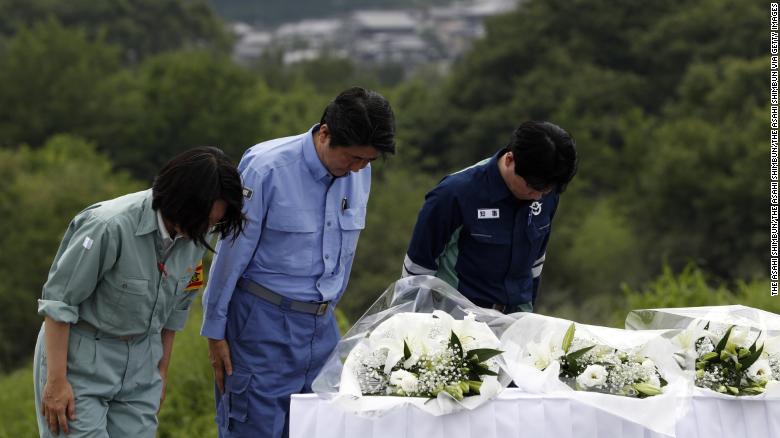
Prime Minister Shinzo Abe offer flowers at a hill he can see the submerged area on Wednesdayv in Kurashiki, Okayama, Japan.
The rapid development of parts of the region meant there was less land to absorb the water, exacerbating the flash flooding. As storm after storm kept coming, the land left that could absorb the moisture reached breaking point, causing the landslides.
"These areas were mapped as high hazard ... it had been decades since there had been something this severe," Bausch said.
Takuro Matsumoto and Dr. Tomoaki Atsumi, two medical workers with Medecins Sans Frontieres, were told by many local residents that the last time the region experienced rains like this was more than 80 years ago.
Speaking to CNN by phone from the city of Kure, they said they managed to treat a couple of dozen people after arriving Thursday night, a week after the rain started falling.
Kure was hit particularly hard, Matsumoto and Atsumi said, with many homes partially submerged in water. Spotty electricity and a heat wave have made their work even more difficult.
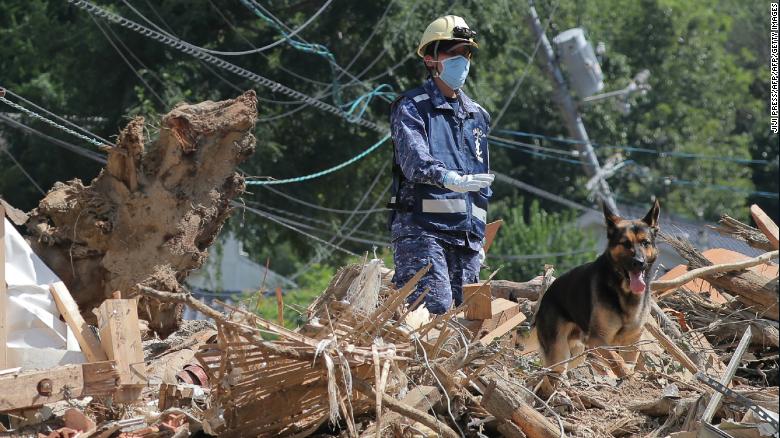
A member of Japan's Maritime Self Defense Forces searches for missing persons at a flood damage site in Kure, Hiroshima prefecture on Thursday.
Long recovery ahead
Survivors will have to rebuild for the long term, but there are plenty of short-term risks for those who weathered the disaster, including mitigating the spread of diseases that can thrive in the aftermath of destructive storms.
Japan's Prime Minister Shinzo Abe traveled to the flooded areas to survey the damage this week, and has promised to support efforts by local governments to rebuild destroyed infrastructure and homes.
The country is no stranger to natural disasters, especially earthquakes, and has experience when it comes to massive clean ups. But this storm may have revealed that authorities need to do more to plan for water disasters.
And it's just at the beginning of cyclone season, with more rain likely coming this summer.
"Now, there's less vegetation to hold back moisture going forward," said Bausch.
Okuma and others allege that authorities have focused too much on urban development at the expense of emergency management and hazard mapping.
"Japan has built up the disaster prevention for quakes very well since the 1995 massive quake, but those for the water disaster hazard are very much behind," he said.
"This disaster will change that."
CNN's Emiko Jozuka, Derek Van Dam and Junko Ogura contributed reporting
- Paid ContentMore from CNN
We use cookies to understand how you use our site and to improve your experience. This includes personalizing content and advertising. To learn more, click here. By continuing to use our site, you accept our use of cookies, revised Privacy Policy and Terms of Use.
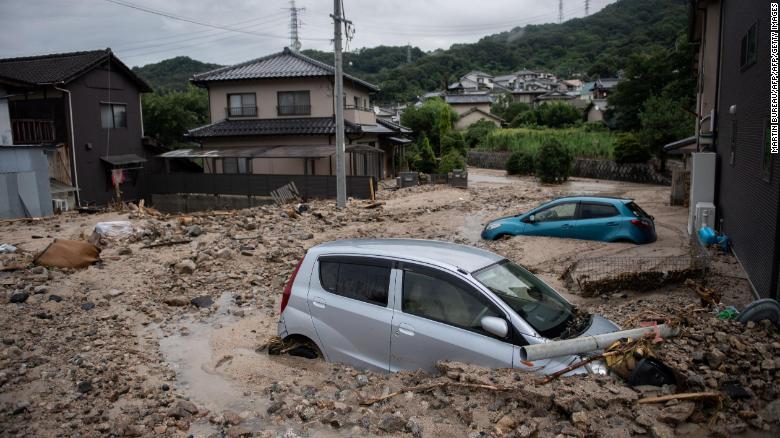
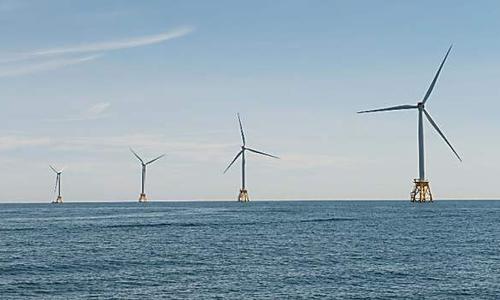
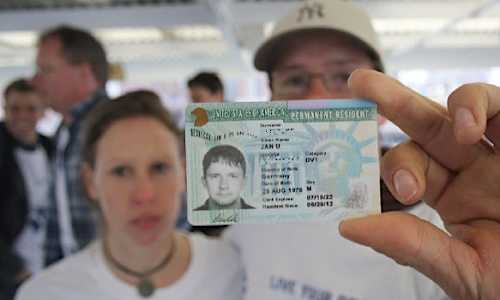




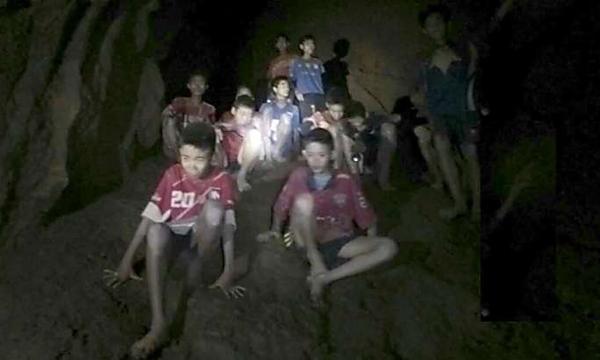






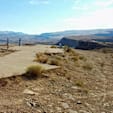







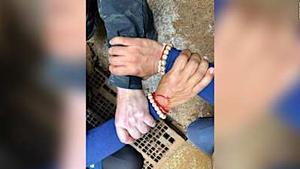
沒有留言:
張貼留言